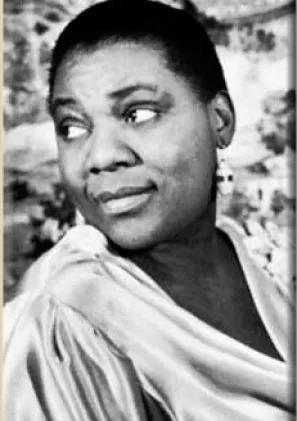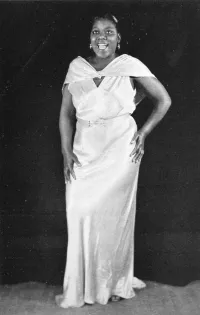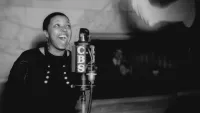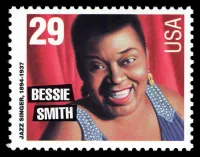Biography
1894 - 1937
"No time to marry, no time to settle down; I'm a young woman, and I ain't done runnin' around.”
– Bessie Smith
Born into poverty in Tennessee, Elizabeth Smith lost both her parents at an early age. At 8 she began performing, earning money by singing on the streets of Chattanooga. By 1912 she had joined a travelling vaudeville troupe and was taken under the wing of blues legend (and possible lover) Gertrude Ma Rainey, With her powerful voice and audience rapport, Smith rapidly became a huge tent show star. In the early 1920s she starred in the musical ‘How Come?’ which went to Broadway. Soon she was known as The Empress of The Blues, the biggest headliner of the black Theater Owners Booking Association, and the nation’s highest paid black entertainer. Smith was already widowed from her first husband when she married her second, Jack Gee, but her open bisexuality prompted her him to leave her. In 1923 she started recording for Columbia Records, the first of her 160 tracks for the label was ‘Downhearted Blues.’ By then she was touring in her own double-decker train carriage which also provided housing when she and her chorus line could not find hotels that would accommodate blacks. She appeared in the film ‘St. Louis Blues’ (1929) and when her Columbia contract ended two years later, she recorded briefly with John Hammond. In 1937 Smith was seriously injured in an automobile accident and had to wait 7 hours before an ambulance would take her to the hospital, where she died of her injuries. Her estranged husband refused to pay for a headstone. 30 years later bisexual Rock and Roll singer Janis Joplin finally bought Smith the memorial she deserved.
1894 - 1937
"No time to marry, no time to settle down; I'm a young woman, and I ain't done runnin' around.”
– Bessie Smith
Born into poverty in Tennessee, Elizabeth Smith lost both her parents at an early age. At 8 she began performing, earning money by singing on the streets of Chattanooga. By 1912 she had joined a travelling vaudeville troupe and was taken under the wing of blues legend (and possible lover) Gertrude Ma Rainey, With her powerful voice and audience rapport, Smith rapidly became a huge tent show star. In the early 1920s she starred in the musical ‘How Come?’ which went to Broadway. Soon she was known as The Empress of The Blues, the biggest headliner of the black Theater Owners Booking Association, and the nation’s highest paid black entertainer. Smith was already widowed from her first husband when she married her second, Jack Gee, but her open bisexuality prompted her him to leave her. In 1923 she started recording for Columbia Records, the first of her 160 tracks for the label was ‘Downhearted Blues.’ By then she was touring in her own double-decker train carriage which also provided housing when she and her chorus line could not find hotels that would accommodate blacks. She appeared in the film ‘St. Louis Blues’ (1929) and when her Columbia contract ended two years later, she recorded briefly with John Hammond. In 1937 Smith was seriously injured in an automobile accident and had to wait 7 hours before an ambulance would take her to the hospital, where she died of her injuries. Her estranged husband refused to pay for a headstone. 30 years later bisexual Rock and Roll singer Janis Joplin finally bought Smith the memorial she deserved.
Demography
Demography
Gender Female
Sexual Orientation Bisexual
Gender Identity Cisgender
Ethnicity African American Black
Nations Affiliated United States
Era/Epoch Harlem Renaissance (1919-1929)
Field(s) of Contribution
Entertainer
Film
Music
Commemorations & Honors
Posthumous Blues Hall of Fame Induction (1980)
Posthumous Big Band and Jazz Hall of Fame Induction (1981)
Posthumous National Women's Halls of Fame Inductee (1984)
Posthumous Grammy Lifetime Achievement Award (1989)
Posthumous Rock and Roll Hall of Fame Induction (1989)
U.S. Postal Service Commemorative Stamp (1994)
Posthumous Grammy Hall of Fame Induction (2006)
Demography
Gender Female
Sexual Orientation Bisexual
Gender Identity Cisgender
Ethnicity African American Black
Nations Affiliated United States
Era/Epoch Harlem Renaissance (1919-1929)
Field(s) of Contribution
Entertainer
Film
Music
Commemorations & Honors
Posthumous Blues Hall of Fame Induction (1980)
Posthumous Big Band and Jazz Hall of Fame Induction (1981)
Posthumous National Women's Halls of Fame Inductee (1984)
Posthumous Grammy Lifetime Achievement Award (1989)
Posthumous Rock and Roll Hall of Fame Induction (1989)
U.S. Postal Service Commemorative Stamp (1994)
Posthumous Grammy Hall of Fame Induction (2006)
Resources
Resources
Albertson, Chris. Bessie. New York: Stein and Day, 1972.
Albertson, Chris. Bessie Smith: Empress of the Blues. New York: Schirmer Books, 1975.
Davis, Angela Y. Blues Legacies and Black Feminism: Gertrude 'Ma' Rainey, Bessie Smith and Billie Holiday. New York: Pantheon Books, 1998.
Kay, Jackie. Bessie Smith. Bath, England: Absolute Press, 1997.
Oliver, Paul. Bessie Smith. New York: A.S. Barnes, 1959.
https://www.pbs.org/outofthepast/past/p3/1925_1.html
https://www.npr.org/2018/01/05/575422226/forebears-bessie-smith-the-empress-of-the-blues
https://www.newworldencyclopedia.org/entry/Bessie_Smith
Resources
Albertson, Chris. Bessie. New York: Stein and Day, 1972.
Albertson, Chris. Bessie Smith: Empress of the Blues. New York: Schirmer Books, 1975.
Davis, Angela Y. Blues Legacies and Black Feminism: Gertrude 'Ma' Rainey, Bessie Smith and Billie Holiday. New York: Pantheon Books, 1998.
Kay, Jackie. Bessie Smith. Bath, England: Absolute Press, 1997.
Oliver, Paul. Bessie Smith. New York: A.S. Barnes, 1959.
https://www.pbs.org/outofthepast/past/p3/1925_1.html
https://www.npr.org/2018/01/05/575422226/forebears-bessie-smith-the-empress-of-the-blues
https://www.newworldencyclopedia.org/entry/Bessie_Smith









